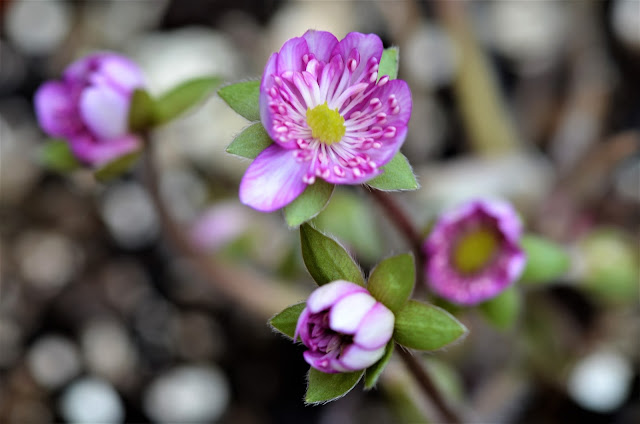I take a lot of photographs of snowdrops at eye level, so as best to appreciate their finer points. Of course, the natural viewpoint is from above so here are two snowdrops I have written about previously, 'au naturel': 'Phil Cornish' and 'Barbara's Double' are shown directly from above so it's hardly natural, just another perspective. Don't they make a bonny couple! I'd venture to suggest the former is one of the nicest marked snowdrops on the market. It's not a cheap buy but better than some, possibly all, that I have seen for huge sums on eBay or at plant fairs. 'Barbara's Double' is one for the collection, just such a pretty snowdrop.
When one pays a pretty sum of money for a single snowdrop cultivar it is reassuring to know that s/he will not stay single for long, and one hopes for large families. Such is the case with the very handsome Galanthus nivalis poculiformis, often referred to simply as 'poculiformis'. It is a pure white form possessing six petals and is particularly good when fully open which today it was not. That apart it is towards the inexpensive end of the Poculiformis Group or, for those whose education was unhampered by Latin lessons, 'little cup' from the Latin 'poculus'. I studied Latin to a decent level at school but believed the form denoted something to do with all white flowers. I should have studied harder for it refers to the form where the inner and outer petals are very similar. So my little fellow may be forgiven for the spot of green on the inner petal. I digress. The original bulb has clumped up very well indeed.
And another hepatica is in flower, the Hepatica japonica 'Imaizumi'. There is a huge range of such varieties sharing one thing in common: they're not cheap. So my collection is limited and will remain so until and if they seed themselves as did the seedling that closes today's blog. it is minuscule in reality.
When one pays a pretty sum of money for a single snowdrop cultivar it is reassuring to know that s/he will not stay single for long, and one hopes for large families. Such is the case with the very handsome Galanthus nivalis poculiformis, often referred to simply as 'poculiformis'. It is a pure white form possessing six petals and is particularly good when fully open which today it was not. That apart it is towards the inexpensive end of the Poculiformis Group or, for those whose education was unhampered by Latin lessons, 'little cup' from the Latin 'poculus'. I studied Latin to a decent level at school but believed the form denoted something to do with all white flowers. I should have studied harder for it refers to the form where the inner and outer petals are very similar. So my little fellow may be forgiven for the spot of green on the inner petal. I digress. The original bulb has clumped up very well indeed.
And another hepatica is in flower, the Hepatica japonica 'Imaizumi'. There is a huge range of such varieties sharing one thing in common: they're not cheap. So my collection is limited and will remain so until and if they seed themselves as did the seedling that closes today's blog. it is minuscule in reality.





If I ever see snowdrops in person, I think I'll at least have some appreciation as to what's an ordinary type as opposed to an unusual one after exposure to your posts! I love the Hepatica, something I don't have a prayer of growing in my climate.
ReplyDeleteI tend to specialise at this time of the year, Kris. I do however grow things that surround grass in warmer months so other than exotic delights of winter I'm sure we'll be on common ground at some stage in the cycle. That said, my ground is rather more common than your oasis.
DeleteThey are such exquisite little flowers, all somewhat but not dramatically different except to aficionados. I suppose an analogous plant in my climate is the Echeveria or the bumpy Kelly Griffin pot-Aloes. One becomes a collector looking for the really special ones, at sometimes alarmingly high prices.
ReplyDelete